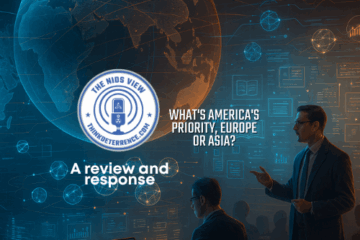Annie Jacobsen’s new book, Nuclear War: A Scenario, is receiving rave reviews. It portrays a scenario in which a limited North Korean nuclear strike on the United States spirals into global thermonuclear war between the United States and Russia, ultimately killing a significant portion of the world’s population. For Jacobsen, who treats her fictional scenario as if it is fact, the problem is American nuclear policy, which, she asserts, is an utter failure. The only solution to the problem she creates is arms control and nuclear disarmament.
In Jacobsen’s scenario, North Korea unexpectedly launches a limited preemptive strike against the American homeland. The United States responds with a decapitating strike against North Korea’s nuclear arsenal. Through unlikely errors, Russia believes that the United States is attacking them instead of North Korea. In response, Russia launches a large-scale strike. This leads the United States to launch everything. Bing, bang, boom, and we have Armageddon followed by nuclear winter and the death of billions. In interviews with Vanity Fair and Mother Jones, Jacobsen argues that the US has a plan to conduct nuclear warfighting, based on a series of previously adopted requirements that leave the president little leeway to modify his response. This problem is only made worse by the fact that the president has sole authority to employ nuclear weapons. To this point, Jacobsen argues that military “war mongers” have a very “aggressive culture” that has a predilection to “jam” the president toward “quickly launching a massive retaliatory strike.”
Jacobsen asserts that American intercontinental ballistic missiles are on “HAIR TRIGGER ALERT.” Why? She interviewed William Perry who used the term. Bam, nuclear weapons are on hair trigger alert and missileers have itchy trigger fingers.
While admitting that nuclear deterrence has worked for seven decades, Jacobsen warns that deterrence will fail and when it does, any use of a nuclear weapon will result in large-scale nuclear war. Why? Jacobson interviewed Paul Bracken, who participated in government sponsored wargames—four decades ago—that ended in general nuclear war. Ipso-facto, the use of one nuclear weapon leads to Armageddon.
In Jacobsen’s scenario, American missile defenses are a complete failure. Why? She interviewed Ted Postol who said they do not work—case closed. Her conclusion is that missile defense is a farce and a waste of money. And the United States is lying to itself if it thinks they will ever stop an inbound nuclear weapon.
Elsewhere in the scenario, the president is forced to launch a large-scale nuclear response against the Russians within six minutes. Why? Jacobsen was also told by Perry that the president “will not wait” and thus assumed that Ronald Reagan’s memoir, in which he made an off-hand remark about having six minutes to decide on nuclear weapons use, reflects policy. Abracadabra, the president must decide to use nuclear weapons within six minutes.
Jacobsen’s predilection for incorrectly contextualizing the statements of those she interviewed is both stunning and worrying. The conclusions she draws about the present from the statements of former, often Reagan era or earlier, officials boggles the mind. Jacobsen does not seem to grasp the fact that she or her interviewees may be wrong about the relevance of their past experience to the present. Three examples are indicative.
Problems
First, Jacobsen is wrong about the alert status of the nation’s intercontinental ballistic missile force. They are not on “HAIR TRIGGER ALERT.” The United States does not have a launch-on-warning or launch-under-attack policy/doctrine. Nothing of the sort exists. Adam Lowther and Derek Williams dismantle this argument and explain that the United States maintains a launch-under-attack option, which allows the president to employ intercontinental ballistic missiles pre-, mid-, or post-strike. The option requires nothing of the president.
A number of variables will influence this decision. What is important to remember is that there is tremendous work that goes into thinking through scenarios well before they ever arise. Thus, the idea that these weapons are on hair trigger alert is ridiculous. Years of planning and analysis take place left of launch.
Second, Jacobsen is clearly unfamiliar with the design and purpose of wargames. They are specifically designed to understand the implications of a concept or capability. This means a scenario is artificially designed to ensure participants achieve the game’s objectives. Thus, when Jacobsen assumes that because a wargame or series of wargames end in general nuclear war, that a real conflict must necessarily end in general nuclear war, she is fundamentally misunderstanding the purpose and arbitrary nature of wargames. Within the wargaming community, it is well understood that they are not predictive of the future but are instructive of potential options.
Third, missile defenses are not worthless, as Jacobsen claims. They are making steady improvements in their ability to destroy targets. Ted Postol, her primary source of information about missile defenses, was wrong about the effectiveness of Israel’s Iron Dome system. Hard data is proving that missile defenses, in this case Iron Dome, are far more effective than Postel believed.
Although there are additional areas where Jacobsen incorporates inaccurate information into her scenario, the point is clear. Annie Jacobsen’s Nuclear War: A Scenario would be far more accurately titled, Nuclear War: A Novel or Nuclear War: Disarmament Propaganda. The biggest challenge with the book is that Americans with little understanding of nuclear operations will believe the bias with which Jacobsen writes. This makes it imperative that those within the nuclear community speak out and correct the record. Nuclear deterrence is too important to turn over to a journalist with an agenda.
Peter Huessy is a Senior Fellow at the National Institute for Deterrence Studies. The views expressed in this article are the author’s own.
About the Author

Peter Huessy
Mr. Peter Huessy is President of his own defense consulting firm, Geostrategic Analysis, founded in 1981, and through 2021, Director of Strategic Deterrent Studies at the Mitchell Institute on Aerospace Studies. He was the senior defense consultant at the National Defense University Foundation for 22 years. He was the National Security Fellow at the AFPC, and Senior Defense Consultant at the Air Force Association from 2011-2016.
Mr. Huessy has served as an expert defense and national security analyst for over 50 years, helping his clients cover congressional activities, arms control group efforts, nuclear armed states actions, and US administration nuclear related policy, budgets, and strategies, while monitoring budget and policy developments on nuclear deterrence, ICBM modernization, nuclear arms control, and overall nuclear modernization.
He has also covered nuclear terrorism, counterterrorism, immigration, state-sponsored terrorism, missile defense, weapons of mass destruction, especially US-Israeli joint defense efforts, nuclear deterrence, arms control, proliferation, as well as tactical and strategic air, airlift, space and nuclear matters and such state and non-state actors as North Korea, China, Iran, Syria, Venezuela and Hezbollah, Hamas, and Al Qaeda. This also includes monitoring activities of think tanks, non-governmental organizations, and other US government departments, as well as projecting future actions of Congress in this area. His specialty is developing and implementing public policy campaigns to secure support for important national security objectives. And analyzing nuclear related technology and its impact on public policy, a study of which he prepared for the Aerospace Corporation in 2019.





I don’t find this article to be particularly reassuring.
First, I am confused about this: “The United States does not have a launch-on-warning or launch-under-attack policy/doctrine. .. the United States maintains a launch-under-attack option, which allows the president to employ intercontinental ballistic missiles pre-, mid-, or post-strike. The option requires nothing of the president.”
So it doesn’t have a policy, it has an option. But, isn’t that what Jacobsen said – the President decides the option? The point is its an under-attack decision. And the President is allowed to “employ” this option, but this “requires nothing of” them – what does that mean? I am struggling to understand how this should make us feel more reassured.
Second, maybe the article is right that these systems are not a “complete failure”. But, it also clearly indicates they are also not ideal: “making steady improvements in their ability”. I am more concerned with the lack of a fail-safe system than I am reassured that the system is not “worthless” – the major risks lie with the former, not the latter.
Finally, it is almost certain that if a nuclear war scenario arises, it will be different to any of the “thinking through scenarios” that have been performed. May be different in a good way or a bad way, but it will be different. I believe her point is that if things start to happen, they happen too fast for a considered response, and there is no precedent.
Even though the book might be a bit of a polemic, there is nothing I see in this response that indicates to me her general idea – a decent chance of things going terribly wrong quickly – is incorrect.
I agree with Michael Lackner, and had the same thoughts about why launch a strike that is likely to be misinterpreted by Russia. Also, why would the Russian president totally dismiss the calls from SecDef and SecState, insisting that POTUS talk to him? Seems kinda like a stretch that the Russian President would launch an all out attack in this scenario, knowing that the US would retaliate. Nonetheless, nuclear weapons are very scary. We’ve been lucky there hasn’t been a significant accident involving them. You might want to check out Command and Control by Schlosser. It goes through all the major accidents involving nuclear weapons, and it scared the crap out of me.
In 1972 , in l One of my additional duties( primary duty being an USAF navigator) was instructing C-130 aircrews in the safest and best method of transporting nuclear weapons from one European USAF base to another. The weapons were disarmed of course, but I personally delivered about 4 thermonuclear bombs from the UK to Italy(I think that was the destination) . We were “splashed” by a couple of F_104 German fighters practicing aerial combat. I reported this reckless event to top commanders in the European theater but never was contacted by the powers to be. Ever since then , and having in retirement studied mucho about Command and Control of Nuclear Weapons, I think the American folks and all countrys
should be educated on how quickly we could evolve in to nuclear Conflict ,e.g.in a heart beat! I don’t think 98% of my fellow Americans realize our current Administration is probably not capable of responding to a Nuclear threat . If the author, Ann, is advocating Nuclear disarming, boy I am on her team. But I am an ex- Air Force officer with no real platform. Sincerely, Jock Harter(Capt USAF).
I’ve listened to several interviews of Annie Jacobsen, was very impressed, and purchased the book. One can criticize the realism of the premise of a “bolt out of the blue” North Korean nuclear attack, but I was willing to “go” with that, as the point of the book is to show what happens when “deterrence” fails. And sometime, from somewhere, deterrence may fail. Others have criticized that her negative portrayal of the effectiveness of anti-missile systems is far too pessimistic. Israel recently achieved extraordinary success in intercepting and destroying the ballistic missiles fired against it by Iran. However, what troubles me more is what seems to be an internal inconsistency in the book itself.
A question I had, before starting the book, was prompted by Jacobsen’s observation repeated in every interview that an ICBM fired against North Korea must fly over Russia. With the potential for Russian misunderstanding, this is terrifying. But doesn’t the Pentagon know this? Why wouldn’t the Pentagon instead have in place a plan to retaliate against North Korea with submarine-launched nuclear missiles, not ICBMs, avoiding the Russia flyover altogether? Doesn’t the Navy routinely patrol submarines within striking distance of North Korea? Reading the book, this appears to be the case, though this fact is buried in a footnote.
Footnote p.94 “missile launch officer” cites an article stating, “Submarines and bombers would be the primary attackers in a scenario involving North Korea.” Subs could “fire 200 warheads roughly 15 minutes after the president gave the order.” Yet in her scenario, on page 133, she portrays the President selecting “option Charlie” to launch fifty Minuteman III ICBMs and only eight Trident SLBMs. Why? This doesn’t seem to make sense and seems inconsistent with the prior footnote.
Any submarine nuclear strike on North Korea would obliterate that country’s missile capability. True, this could produce significant casualties in southern China and eastern Russia (as she points out on page 95) that might precipitate retaliation. But a submarine strike would not trigger the mistaken Russian belief that Russia was under attack. She cites no authority to support that ICBMs would be the preferred “menu option” to attack North Korea in a nuclear crisis. I assume the black book options are highly classified, but if the article she cites in her footnote is accurate, retaliation with submarine-fired Trident SLBMs would seem to be a more plausible scenario. Any risk of escalation should be analyzed under THAT scenario, not the scenario of a massive U.S. ICBM attack flying over Russia that she crafts in her storyline.
The fact that Jacobsen used the ICBM counter-attack as a major plot element gives me pause that her book is not as objective as she portrays it to be.